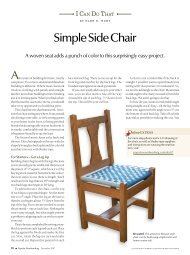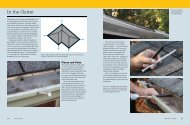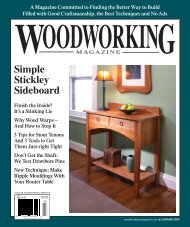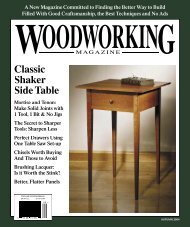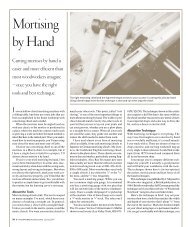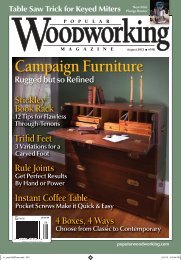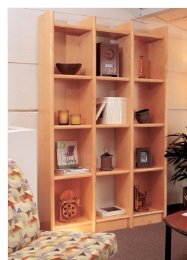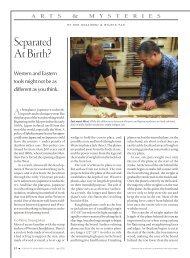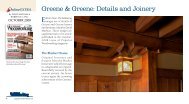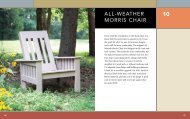Classic Shaker Side Table - Popular Woodworking Magazine
Classic Shaker Side Table - Popular Woodworking Magazine
Classic Shaker Side Table - Popular Woodworking Magazine
You also want an ePaper? Increase the reach of your titles
YUMPU automatically turns print PDFs into web optimized ePapers that Google loves.
time measurement starts with the removal of thefinger and ends when the stream flowing throughthe hole breaks its continuous stream. Ordinarywater took 11.7 seconds for the 3.5 ounces tobreak stream. The Deft brushing lacquer took30.5 seconds, while the Watco took 31.1 seconds.Minwax’s Fast Dry Polyurethane, an oilbasedfinish, required 40.98 seconds. McClosky’sHeirloom Varnish, another oil-based finish, took1:32.88, while another Minwax product, a waterbasedPolycrylic, required 32.88 seconds.These readings indicate how the finishes willperform when being brushed. The thinner lacquersand water-based materials will level betterthan the varnish and the Fast Dry poly. Brushmarks will be even less of a problem if goodbrushing technique is used; this is a requirementbecause lacquers are thinner and more aptto run or sag if too much finish is applied to anysurface other than a horizontal one.Using a BrushApplying any finish material with a brush requiresthe right techniques to avoid the occasional selfinflictedsurface imperfections.Start with a decent and appropriately sizedbrush for the job. A brush that’s 2"-2 1 ⁄ 2 " wideshould be used for all the large, flat surfaces.Choose a 1" brush for smaller work or jobs thathave more details, such as turned objects withmultiple beads or other irregular shapes.Use a natural China bristle brush with bristlesthat have been “flagged” (these are roughlyequivalent to human hair split-ends). The tip ofthe brush should be chisel-shaped. These two featuresallow the brush to carry more finish materialto the surface and spread the material morefinely as it flows off the brush. Avoid the temptationto use foam brushes because the lacquersolvents will break down the adhesives that holdthe brush together.Make sure the contents of the can are thoroughlymixed by stirring or, in spite of the can’slabel warning against it, shaking. Shaking the candoesn’t cause bubbles in your wet finish. The primaryreason bubbles appear is from overbrushingduring application. Turbulence occurs at the pointIf the coat of lacquer is still very wet, you canbrush out a run, such as the one shown here.of contact between the bristle tips and the surfacebeing finished. This turbulence is the causeof bubble formation, not the transfer of bubblesfrom the can to the surface. This is another reasonwhy a continuous, gentle stroke is superiorto back-and-forth brushing.A fresh can of lacquer is not likely to requireany thinning. However, a can that has been openfor a period of time or is half-empty may need asmall amount of lacquer thinner added.Load the brush with lacquer by dipping it intothe can and begin brushing flat surfaces with asfew strokes as possible, using only the tip of thebrush. Consider the brushing as more of a draggingmotion along a straight line than actual backand-forthstrokes. Also, start brushing at an edgeand move in the direction of the grain.When the lacquer stops flowing off the bristles,lift the brush, turn it over, then restart just aninch or two back from where you stopped. Continueas before until the material stops flowingoff the brush, then reload the brush and continue.When you come to the end of the first row, liftthe brush off the surface. Think of it as a “takeoff”from an aircraft carrier.With a full wet row applied, go over the rowagain in one continuous stroke, holding the brush90° to the surface using just the very tip of brush.This technique, called “tipping off,” will eliminatemost of the bubbles in the finish and levelout any brush marks, including where a pick-upbrush stroke began.With one full row of finish applied, begin thesecond row using the same technique. For eachsuccessive row, overlap the previous row only asmall amount – just enough to blend the two rowstogether. Continue until the surface is done, thenmove on to the next unfinished area.The amount of lacquer to apply as a wet coatwill depend on what you are brushing: either ahorizontal surface, such as a tabletop, or a verticalsurface, such as a cabinet side. With verticalsurfaces, less material must be applied or it willdevelop runs or sags. Experimentation and experiencewill guide you. A sound brushing techniqueand paying close attention to the work is the bestprevention against brush marks, sags and runs.A sound brushing technique will deter a sag, suchas the one shown here.“Show us a man who never makesa mistake and we will show a manwho never makes anything. Thecapacity for occasional blunderingis inseparable from the capacity tobring things to pass.”Herman Lincoln Wayland (1830 - 1898)authorIf you detect a run and the coat is still verywet, you can brush it out. Keep in mind that youneed to work with “deliberate speed” so the freshcoat doesn’t start to set up before you go backover an edge when lapping one row to the next,or during the “tipping off” stroke. One factor thatwill, in part, determine the speed of work is thethickness of the coat, because a heavier coat willtake longer to set up than a light one.Three Coats are TypicalAfter the first coat dries, it will likely be somewhatrough to the touch. This is easily remediedwith a light sanding using #360-grit lubricatedsandpaper, such as Norton abrasives 3X brandor 3M’s Tri-M-Ite. These lubricated papers willprevent the finish from clogging the abrasives onthe sandpaper. If you’re working over a stainedsurface, be careful not to sand through the finishand cut into the stain color.After sanding, the second coat will apply moresmoothly with very few bubbles produced (lessturbulence). After the second coat, sand as necessaryto smooth the finish once again. The thirdcoat should be left unsanded.Three coats of a lacquer finish applied witha brush will produce a smooth, durable, nearpiano-qualityfinish with the least amount ofwork, compared to other brushing materials.It’s easy to work and dries exceedingly quickly,which means you can finish most projects in asingle day. Used safely with ample ventilationin an area free of open flames or sparks, lacquercould become your finish of choice – if the odorisn’t too objectionable. If it is, a respirator caneasily solve that problem.As a final note, some brushing lacquer brandsoffer a lacquer sanding sealer to be used as a firstcoat. Using it is optional. Sanding sealers containa substance that makes sanding them easier thansanding regular lacquer. This is a convenienceand certainly does no harm. However, the veryproperty that makes it easy to sand also makesthe material softer. Don’t make the mistake oftrying to use a sanding sealer as a complete finish,as it offers far less protection than when it isused appropriately as a first coat. WM— Steve Shanesywoodworking-magazine.com ■ 31



